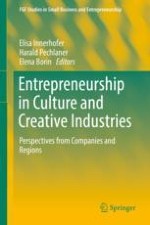2018 | OriginalPaper | Chapter
When Culture Meets Economy
The Role of Art, Culture and the Creative Industries in Regional Innovation Systems
Authors : Harald Pechlaner, Elisa Innerhofer
Published in: Entrepreneurship in Culture and Creative Industries
Publisher: Springer International Publishing
Activate our intelligent search to find suitable subject content or patents.
Select sections of text to find matching patents with Artificial Intelligence. powered by
Select sections of text to find additional relevant content using AI-assisted search. powered by
